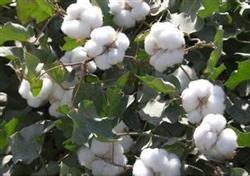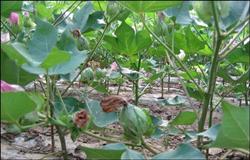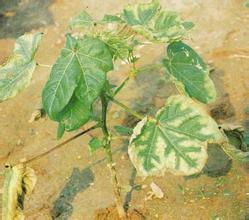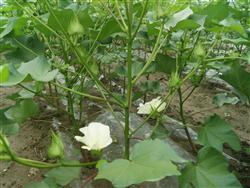bud bolls Learn more about bud bolls
-
How to prevent cotton bud and boll shedding from growing cotton

(1) the general law of bud and boll shedding ① the ratio of bud and boll shedding in bud and boll shedding, the general trend of the ratio of bud to boll drop is that the boll drop rate is higher than the bud drop rate, and the ratio is about 3:2. At the age of bud and boll shedding in ②, the shedding was the most on the ll~20 day, more than 20 days after budding.
2020-11-08 Plant cotton how to prevent flower bud boll shedding one -
Causes and Control measures of Cotton Bud and Boll shedding

Causes and Control measures of Cotton Bud and Boll shedding
2019-02-12 -
Analysis of Cotton Bud and Boll drop

A large number of bud and boll shedding often occur in cotton production, which seriously affects the cotton yield and the income of cotton farmers. As there are many reasons for bud and boll shedding, only "symptomatic treatment" can effectively reduce bud shedding and improve yield and benefit. First, the breed factor. Blind Toona sinensis and cotton bollworm like to lay eggs on hairy cotton varieties, and hairy varieties increase the adhesion of eggs, which are not easy to be blown down by the wind and washed away by Rain Water, so they suffer seriously, resulting in a large number of buds and bolls falling off. The varieties with smooth leaves are more hairy than those with more hairs.
2019-01-16 -
The causes and Control measures of the latest Cotton Bud and Boll shedding

The phenomenon of a large number of Lei Ling falling off often occurs in cotton production, which has a huge negative impact on the yield, which seriously leads to the failure of farmers' harvest and seriously affects the economic income. So what is the reason why cotton buds and bolls fall off? How to prevent and cure it? The following editor is big.
2020-11-10 The latest cotton bud bolls shedding causes and control measures -
Scientific fertilization can reduce cotton bud and boll shedding.

The vegetative growth (root, stem, leaf growth) and reproductive growth (bud, boll, boll growth) of cotton are not coordinated, resulting in the imbalance of the supply, transport and distribution of photosynthates in cotton plants, which is an important reason for the shedding of cotton buds and bolls. Through comprehensive measures centered on fertilization, controlling cotton growth is an important means to reduce cotton bud and boll shedding. Practice has proved that controlling the stem and leaf growth of cotton in the early stage, setting up a high-yield shelf in the middle stage to make it grow steadily and preventing premature senescence in the later stage is an effective way to reduce the shedding of buds and bolls in the middle and lower parts. Therefore, in addition to reasonable close planting, strengthen the water
2019-01-16 -
Key measures for management of cotton boll opening period

During the boll opening period, high-yield cotton looks precocious and does not senescence prematurely, which requires boll opening in the lower part of the plant, continued flowering in the upper part, and few late buds. The robust growth of cotton, the top fruit branch flat extension, fruit branch length of 20 cm 30 cm, there are 3 buds 4. If the top fruit branch stretches up too long, buds grow, and flowers break too late, it is prosperous and greedy at night.
2018-09-12 -
Cotton: Proper management can reduce boll shedding

There are three main reasons for cotton bud and boll shedding: one is physiological shedding, which is also the main reason for shedding. Because of the mutual influence of meteorological conditions and nutritional conditions, it leads to metabolic imbalance in cotton plants and insufficient nutrition, resulting in physiological shedding of buds and bolls; The other is that adverse weather conditions aggravate the harm of diseases and insect pests. Cotton aphids, red spiders and other pests bite leaves, reducing the photosynthetic capacity of leaves, resulting in malnutrition of buds and bolls, increasing shedding, excessive spraying, high concentration of liquid medicine, short spraying time interval and other phytotoxicity, which will also increase.
2019-01-16 -
Cotton planting technology: how to manage cotton flowering and boll period?

How to manage the cotton flowering and boll period? Please introduce the management methods of cotton flower and boll stage can refer to the following methods: 1. Fertilization: a large number of cotton peaches are formed in the flower and boll stage, which is the period in which cotton needs the most nutrients in its life. Re-application of flower and boll fertilizer is the key measure to protect summer peach, compete for autumn peach and prevent premature senility. The amount of topdressing should generally account for the amount of topdressing.
2018-07-18 -
Observation on the application of quasi-flower and boll fertilizer to cotton peach

In the middle and later stages of cotton growth, flower and boll fertilizer should be applied accurately according to the changes of peach and leaf color. Generally, the soil fertility is good, the seedling bud is fat, the bud florescence is prosperous, the leaf is large, the leaf color is dark, the Internode is sparse, the bract leaves do not wrap the bud tightly, the peach is few, and the leaf color does not fade when the first flower is blooming, so the boll fertilizer in the cotton field can not be applied early, but should be pushed to increase the number of peaches and apply it when the leaf color turns light. On the contrary, poor soil fertility, low amount of seedling bud fertilizer, weak bud growth, small leaves, light color of leaves, short and thin internodes, light color of bracts, few buds and yellowish leaves at early flowering can be supplemented with 5kg urea relay per mu.
2019-01-15 -
Key Technical points of Cotton Boll period Management

The period from cotton flowering to boll maturity is called flowering and boll stage. In general, from the first ten days of July to the beginning of September, the growth of cotton in flower and boll stage is still vegetative growth and reproductive growth at the same time, but gradually shifted from vegetative growth to reproductive growth. The main direction of this period is to add three peaches. Its management technology mainly includes five aspects. The main results are as follows: 1. re-apply flower and boll fertilizer and cover fertilizer. The fertilization time is applied when two bolls are sitting in the lower part of the cotton plant at full flowering stage, and the standard nitrogen is 10kg / mu and 15kg / mu. If the soil fertility is poor, the cotton plant grows weakly and the soil.
2019-01-16 -
Emergency measures for Cotton Bud and Boll shedding

When cotton grows in high temperature and rainy climate, a large number of buds and bolls will fall off, resulting in plant height, size and emptiness, resulting in a large reduction in yield. According to the causes of different shedding, corresponding emergency remedial measures can be taken. For cotton fields that have been dry for a long time without rain and can not be watered, the leaves of cotton plants are thin and small, the leaves are light green and yellow, the chaff of buds is small, heavy rain falls heavily, light rain falls less, and no rain falls gradually. Remedial measures: 200 grams of multi-element boron fertilizer per mu plus 20 ml of Fengchengning, evenly sprayed with 50 to 60 kg of water, interval
2019-01-16 -
Planting and Management Technology of Cotton

Cotton is one of the most important crops in the world, with high yield and low production cost, which makes the price of cotton products relatively low. Cotton fiber can be made into a variety of fabrics, from light and transparent Barry yarn to thick canvas and velveteen, suitable for making all kinds of clothes and homes.
2020-11-09 Cotton flower planting and management technology cotton yes in the world -
Causes of Bud and Boll shedding in planting Cotton

First, physiological shedding accounts for about 60-70% of the total shedding of buds and bolls, mainly due to improper management and diseases and insect pests, resulting in plant malnutrition and insufficient nutrition needed for bolls. There are mainly the following three aspects: 1. Root system dysplasia and water absorption.
2020-11-08 Species cotton bud bolls shedding cause one physiology -
Key points of Cotton Field Management

Water and fertilizer are the two most active factors in cotton production measures, and the regulation, promotion and control of water and fertilizer play a very important role in determining cotton yield. But some cotton farmers are impractical, in order to pursue higher cotton yield and higher cotton planting efficiency, blindly irrigate and fertilize, resulting in cotton yield decline, and even some cotton field water.
2018-09-10 -
Field Management of Cotton at Bud stage and Flower and Boll stage

The management of cotton bud stage and flower and boll stage is centered on the regulation of water and fertilizer, with the measures of ploughing, chemical adjustment and pruning, rational use of promotion and control techniques, promotion and control combination, strong and stable growth, high yield shelves, increasing bud bolls, reducing shedding, and realizing the full hanging of three peaches. First, the bud stage of fertilizer and water management requires the stable growth of cotton plants, so steady application and skillful application of fertilizer are required to control the use of nitrogen fertilizer. Cotton fields with medium and high fertility are no longer fertilized. If the soil fertility is poor or the basal fertilizer is insufficient, urine is usually applied every 667 square meters.
2019-01-16 -
How to prevent cotton from rotten bolls (peaches) in rainy season?

How to prevent cotton from rotten bolls (peaches) in rainy season? Please introduce the rainy season can refer to the following methods to prevent cotton boll rot (peach): 1, scientific fertilization: at present, most of the cultivation is insect-resistant cotton, generally requires a large amount of base fertilizer and bud fertilizer, do not apply flower and boll fertilizer, in order to prevent excessive growth, shade aggravation. It is necessary to control nitrogen and increase phosphorus.
2018-07-18 -
When is the flowering and boll period of cotton? How to control the management of water and fertilizer? How to apply fertilizer?

After the cotton topping, it entered the flower and boll stage, which is not only the key period for the formation of cotton yield, but also the peak of water and fertilizer demand, during which cotton field management is very important. When is the florescence and boll period of cotton? How to control the management of water and fertilizer? Cotton flower and boll
2020-11-09 Cotton flower boll period is when water and fertilizer management how put -
Skillful management of cotton bolls

Skillful management of cotton bolls
2018-06-30 -
A New Cotton Variety-Nongda 94-7

Characteristics: the strain has short growth period, fast boll rising, no frost after flower, plant tower type; plant height 80-90 cm, leaf size moderate, leaf color dark green, good ventilation and light permeability, less bud and boll shedding, less crazy branches, strong boll grafting per plant, up to 160. Superfluous buds are easy to form buds and bolls, which can be pruned or unpruned, with a boll weight of 5.6-6.1 grams, smooth and concentrated boll spitting, easy to pick, white cotton, high lint percentage and 41% lint percentage. Key points of cultivation: application of sufficient base fertilizer, heavy application of flower and boll fertilizer and potash fertilizer, supplementary application of top fertilizer, chemical control
2019-01-16 -
Saline-alkali resistant cotton f502-2

First, the characteristic plant tower type, Ⅱ type fruit branch, the plant type is loose, the leaf color is dark green, the common leaf shape, the medium size, the leaf surface is smooth, the leaf is thin and hard, the fruit branch is slightly upward. The seedling emerges quickly, neatly, the growth is robust, the seedling growth potential is medium and stable, the plant grows rapidly before and after the bud stage, the first fruit branch node is 6-7 nodes, the plant height is about 70 cm. The boll setting ability is strong, there are 10 bolls per plant, the boll shape is oval, large, the single boll weighs 6.6 grams, the bell shell is thin, the boll opening is concentrated and smooth, and the boll strength is good.
2019-01-16
